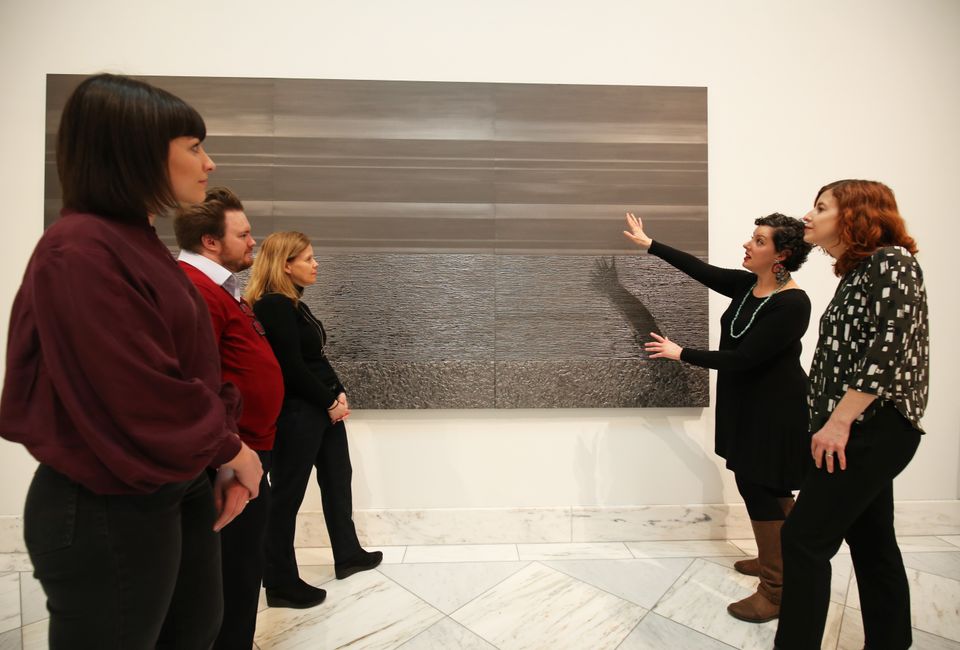
Susana Rodriguez (second from right) talking about Nocturne (Horizon Line). Photo by Libby Weiler.
Art Bites is a new series on Eye Level based on lunchtime talks at the museum. They feature the voices of SAAM's research fellows who share their discoveries about artworks from the collection. Susana “Xuxa” Rodriguez was a 2017-2018 Predoctoral Fellow at SAAM and is currently a Visiting Student at SAAM and NPG.
Close your eyes and touch a piece of cloth. Feel the grain of its threads going along or against your fingers as you read it with your hands and what that feeling brings up for you: where does your tactile sense take you? Is it a memory of another time and place? Maybe the feeling of a parent’s shirt sleeve against your cheek as they carried a younger, sleepier you? The feeling of a light scarf against the flushed warmth of a teenaged you’s cheeks as you walked to school with friends on a brisk autumn morning?
This idea of responding with your senses and collaborating with an object to make meaning are two of the ideas behind Teresita Fernández’s studio practice that we can experience at work in Nocturnal (Horizon Line) (2010). At first glance, the piece appears to be a single panel with different shades of grey paint, but on closer inspection things aren’t as they seem: Nocturnal is actually three panels with a custom paint that is brushed on in its top third, dripped thickly across its middle third, and finally poured into a mold and allowed to harden before being glued onto the lower third with more paint.
SAAM's conservation department shared that the paint is made from mixing graphite and epoxy together. Yes, you read that right: the paint is made from the same material you can find in your pencils and batteries! The graphite this paint is made from is from Borrowdale in Cumbria, England, which is where the mineral was first discovered in the 1500’s. Fernández said that because it didn’t exist culturally before this moment, this connection ties the site intimately to the history of drawing and writing. The different shades of grey are not actually differences in the paint hue itself but the interplay between the different ways that the paint is applied to the surface and how light interacts with it as we walk up to, across, and back from the painting as we view it.
In an interview by Lale Arikoglu for White Wall, Fernández said she’s interested in “the correlation between the cosmos and the subterranean.” We can think of this as the exterior and interior relationships between the viewer and the painting: when we experience a work of art, we make meaning with it by sometimes remembering other times we’ve seen similar pieces, or recalling memories and experiences that the work, its subject, its form, and its setting may evoke in us.
When I look at Nocturnal (Horizon Line), I see the horizon of the beach from my childhood weekends back home in Miami, Florida. There, where the Gulf Stream carves out the Florida Straits like a liquid borderlands between the Atlantic Ocean and the Caribbean's Greater Antilles, is where thousands of Cubans and Haitians have taken their chances crossing the Gulf Stream in their search for freedom from the dictatorships, hardships, and loss of civil liberties on the islands they had called home. I play in my mind the news footage of the dozens upon dozens of homemade rafts and repurposed boats that reached the South Floridian shores. Each craft brimmed with hundreds of smiling and crying faces thankful to make it ashore in the hopes of a better future defined by liberty--the promise of America, the compass that guided their way.
Now let’s take another look at Nocturnal (Horizon Line). What do you see? What do the glittering brushed, dripped, and molded graphite surfaces call up? Is it a landscape? The prairie? A seascape? A memory of camping or waiting for boats to come ashore? When you collaborate with an artwork to make meaning together, the possibilities are endless.


















